A Non-Stop Journey of Over 225 Miles in Four Hours
FAMOUS TRAINS - 9
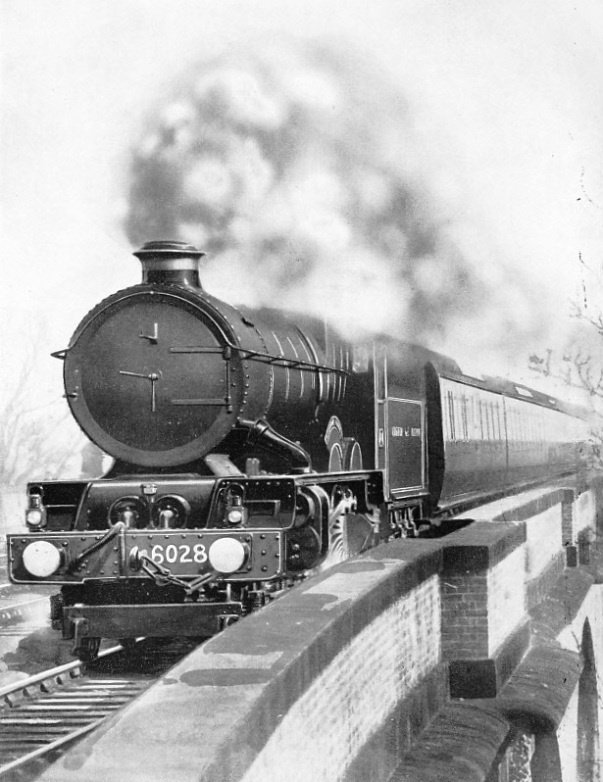
ON THE ROUTE OF THE “CORNISH RIVIERA LIMITED”. An express on the Great Western line near Hanwell, a few miles out of Paddington. The train is hauled by the “King” class locomotive "King Henry II". The locomotive has 6 ft 6 in driving wheels, four cylinders 16¼ in. diameter by 28 in stroke, carries 250 lb per sq in working pressure, and weighs with tender 135¾ tons in working order.
THE story of the “Cornish Riviera Express” brings to mind that of the phoenix. That notable bird, so mythology declares, disappeared from view in flames on a funeral pyre, only to arise to life again from the ashes, a far finer creature than ever before. So it was that, in earlier Great Western Railway days, the most famous train on the line was undoubtedly the “Flying Dutchman” - as well known a traveller to the west as was the “Flying Scotsman” to the north.
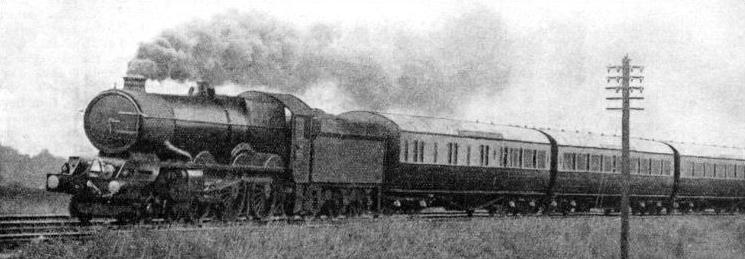
THE EXPRESS APPROACHING WESTBURY, in Wiltshire, ninety-five and a half miles out of London. During the summer the “Cornish Riviera Express” covers the distance between London and Plymouth - 225½ miles - in four hours non-stop. The journey on to Penzance, England’s most westerly station, 305¼ miles from Paddington, is accomplished in six and a quarter hours. In the winter the express halts at Exeter, and lakes six and a half hours. The minimum formation of the express is fourteen coaches, which is sometimes increased to sixteen. The normal weight behind the tender is about 505 tons. The express began to run in 1904.
On July 1, 1904, a rival train appeared. At 10.10 am during the months of July, August, and September of that year, an express left Paddington for Penzance. This at once achieved world note by making the longest daily non-stop run that had ever figured in any time-table up to that date. The run was from London to North Road Station at Plymouth.
Two years had still to elapse before the shortened route to the west via Westbury was brought into use, so that this new “flyer” at first travelled via Bristol. That made the length of non-stop run no less than 245½ miles, for which a time of 4 hours 25 minutes was allowed. Calling at the principal stations in Cornwall, the new train reached Penzance at 5.10 pm. A similar daily service was run in the opposite direction from Penzance to London, non-stop from Plymouth to Paddington.
The following summer the same express reappeared; and then, on July 1, 1906, there came that great day in Great Western history on which the twenty-four miles of new line from Castle Cary to Cogload Junction, near Taunton, were opened for traffic, and the Westbury way to the west was at last complete. With the use of the recently-built spur line from Patney to Westbury, it cut twenty miles from the journey from Paddington to Taunton, and all stations west of that point.
For the third time the new train reappeared in the time-tables, diverted now, of course, to the new route, and accelerated to make the run of 225½ miles to Plymouth in 4 hours 7 minutes. But this time the reappearance was permanent. The “Cornish Riviera Express” had come into being, and since then it has continued almost unbrokenly in service, winter and summer alike. So the “Flying Dutchman”, totally outclassed, sank into insignificance, and is now nearly forgotten; and a new and far more spectacular “flyer” arose to fame in its stead.
In July, 1903, something in the way of a preliminary experiment had been made. The Prince and Princess of Wales - later King George V and Queen Mary - were travelling to Truro, and it was arranged that their train, leaving Paddington at 10.40 am, should run non-stop to Plymouth. “City of Bath” - a 4-4-0 of the same type as “City of Truro” was at the head of the five-coach special, and a most remarkable run was made.
Probably, indeed, it was the fastest journey that has ever been made by Royalty in this country. For most of the way to Exeter speed was maintained at well over seventy miles an hour; Bath, 107 miles from London, was passed in 82 minutes; Bristol, 118¼ miles, in 104½ minutes; and Exeter, 193½ miles, in 172½ minutes; and, after having surmounted the mountainous gradients west of Newton Abbot, “City of Bath” pushed into North Road Station, Plymouth, at 2.33½ pm, 36½ minutes ahead of time. The distance of 245½ miles had been completed in 3 hours 53½ minutes - a wonderful feat more than three decades ago, even allowing for the lightness of the train.
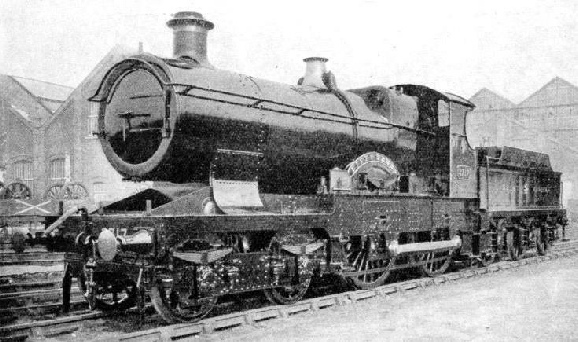 “CITY OF TRURO”. In 1903 the “City of Bath”, a similar engine, hauled a royal train between Paddington and Plymouth via Bristol in record time- The 245½ miles were covered in 3 hours 53½ minutes. The “City” type engines had driving wheels of 6 ft 8½ in, and a boiler pressure of 195 lb per sq in. Cylinders measured 18 in by 26 in, while the heating surface was 1,818 sq ft.
“CITY OF TRURO”. In 1903 the “City of Bath”, a similar engine, hauled a royal train between Paddington and Plymouth via Bristol in record time- The 245½ miles were covered in 3 hours 53½ minutes. The “City” type engines had driving wheels of 6 ft 8½ in, and a boiler pressure of 195 lb per sq in. Cylinders measured 18 in by 26 in, while the heating surface was 1,818 sq ft.
This run amply proved the practicability of a daily non-stop journey, which, as already mentioned, came into operation in the following year. A competition was instituted to find a suitable title for the new service. It is curious to recall that “Cornish Riviera Limited” was submitted by four competitors, but did not win the prize. The “Riviera Express” was the prize-winner, but in course of time “Cornish Riviera Limited” was substituted. “Cornish Riviera Express” has now become the accepted title of the train. Nevertheless the earlier title took the fancy of the Great Western staff, and up and down the line this famous train has but one name among the men. It is known quite simply as “The Limited” - a convenient title.
Yet nothing more paradoxical can be imagined. A glance at the train as it leaves Paddington would suggest “The Unlimited” as a more suitable appellation. When it first ran, in 1904, five light corridor coaches and a dining-car, weighing 140 tons behind the engine tender, sufficed for all traffic needs. To-day the minimum formation is fourteen, coaches of the latest stock, weighing, with passengers and luggage, fully 500 tons. At times of pressure the formation is permitted to increase to sixteen coaches, or 575 tons all found.
In 1904, 4-4-0 locomotives of the “City” class were chiefly responsible for the working, occasionally displaced by one of the three French compound “Atlantics”, which the Great Western Railway purchased at about that time. Since then, the two-cylinder 4-6-0 “Saints” have displaced the 4-4-0’s; the “Saints” in their turn have given place to various classes of “Stars”; “Castles” came to replace “Stars”; and last of all the mighty “Kings” have been brought into service and now hold the field. What is more, the “Cornish Riviera Express” needs the services of a “King”. In view of the load and the gradients to be encountered, it is one of the hardest worked trains in the country.
An inspection of the train at Paddington station before starting shows it to be one of the most multi-portioned expresses in existence. It carries in all eight independent sections, which are to be spread far and wide over the West of England during the course of the journey. The majority of these are composite brake coaches - each one a self-contained unit, with two first-class and four third-class compartments, two lavatories, and a guard’s brake compartment.
Next the engine is that part of the train which corresponds with the original express of 1904 running through from Paddington to Penzance. It comprises six coaches - a third-class brake, first- and third-class composite, third-class restaurant car, kitchen and first-class restaurant car, first- and third-class composite and third-class brake. Then, in succession, come composite first- and third-class brake coaches for St. Ives, Falmouth, Newquay, Kingsbridge, Minehead, Ilfracombe, and two for Weymouth, making in all eight portions and fourteen vehicles.

“EVENING STAR”. The “Star” class engines were among those detailed to haul the “Cornish Riviera Express” in former days. These locomotives were the first four-cylinder engines to be built by the GWR. The driving wheels were 6 ft 8½ in in diameter, the length over buffers was 64 ft 2 in. The boiler pressure was 225 lb per sq in. The cylinders measured 14¼ in diameter by 26 in stroke.
The uninitiated passenger, knowing the first stop of the train to be Exeter, may perhaps wonder how through coaches are to be run on this train for Weymouth, Ilfracombe, and Minehead, seeing that Westbury is the junction for Weymouth, and Taunton the junction for the other two. The answer, of course, is found in the practice of slipping coaches. Two coaches are therefore slipped at Westbury and two at Taunton; the Kingsbridge coach is detached at Exeter, the Newquay coach at Par, in Cornwall, the Falmouth coach at Truro, and the St. Ives coach at St. Erth, not far short of Penzance. It is thus fortunate that four coaches have disappeared from the tail of the train before the steep climb is reached from Taunton up to Whitehall Summit, in the Blackdown Hills; while the reduction from fourteen to nine coaches on leaving Exeter Station enables the “King”, which has worked the train from Paddington, to continue without assistance over the exceptionally severe gradients between Newton Abbot and Plymouth.
On the opening of the Westbury route, in 1906, the departure time of the “Cornish Riviera Express” was altered from its previous 10.10 am to 10.30 am, and there it has remained ever since, except for a short period in the latter part of the war of 1914-18, when it became 10.15 am, and in common with all other British train services, the running was much slowed down. For many years after that this famous express held the world’s record for the longest non-stop run scheduled in the time-tables of any railway, either in Great Britain or abroad - the run of 225¾ miles from Paddington to Plymouth.
Three Slip Portions
Until after the war, Exeter was served by means of a slip coach, so that three slip portions were detached in succession - at Westbury, Taunton, and Exeter - before the first stop was reached. This was not a record, however, as, on the opening of the Bicester route from Paddington to Banbury, certain of the “two-hour trains” were scheduled to slip three times before the first stop was made, at Birmingham. The claims of Exeter being too important to overlook on the up journey, it was arranged to stop the “Cornish Riviera Express” there to pick up passengers for London. This arrangement has always continued except during the height of the summer season, when the “Limited” is non-stop both ways between Paddington and Plymouth. But the up “Limited” is generally much the easier of the two trains to work, as it has no Ilfracombe, Minehead, and Weymouth portions, and is therefore lighter. Further, since it is allowed four hours fifteen minutes from Plymouth to Paddington, it is not quite so fast as the down train.
Considerations of economy, coupled again with the rising importance of Exeter, ultimately compelled an alteration to the down working. In 1928, therefore, the Exeter “slip” was withdrawn, and arrangements were made to stop the train there instead, so that passengers could be picked up as well as set down. Before that date, however, the G.W.R. had lost the “longest non-stop run” record, which passed in succession to the LMS and to the LNER. The up “Royal Scot” now runs all the year round from Carlisle to Euston, 299 miles, without a stop. In the summer season, the “Flying Scotsman” has even longer non-stop journeys of 392¾ miles between King’s Cross and Edinburgh and vice-versa.

AT ST. ERTH STATION in Cornwall, 299½ miles from Paddington on the Great Western line. Palm trees and ferns grow at the side of the platform. At this station, the last halt before Penzance, the St. Ives through coach is detached.
But the additional stop at Exeter did not result in a longer journey time. Despite the increase in the weight of the train, the time from Paddington to Plymouth had been pared down from four hours seven minutes to exactly four hours, and it was found possible to put in a three-minute stop at Exeter, and still to reach Plymouth in no more than four hours four minutes. So during the summer season the “Cornish Riviera Express” still keeps up its four-hour non-stop run from Paddington to Plymouth, and carries slip coaches for Weymouth only; but from October till early in July, Exeter becomes the first stop from London, and slips are detached at both Westbury and Taunton.
The daily start from Paddington is always an event of some importance. From the rear end of No. 1 platform the great train sometimes stretches out of sight round the curve at the other end. A knot of admirers of all ages invariably gathers round the locomotive, and not a little hero-worship of engines and their crews takes place. The engine, which will work through to Plymouth, is a “King”, drawn alternately from Old Oak - the principal London engine-shed - and from Laira shed at Plymouth, and a certain quiet rivalry exists between the two depots in the working of the famous train.
Prompt to time at 10.30 am the “right-away” is given. In this one run of 225½ - a quarter of a mile has now been deducted from its length, for reasons that will be explained - the engine is going to travel over what are probably the two greatest extremes of main line grading in Great Britain. The first thirty-six miles, to Reading, are ever Brunel’s original main line to the West, with no steeper gradient than 1 in 1,320 - that is, practically dead level. Between Newton Abbot and Plymouth, on the other hand, there are lengthy stretches, on the southern slopes of Dartmoor, as steep as 1 in 40 to 1 in 50. There is even a short strip at 1 in 36, which is probably the steepest incline in the country on any first-class main line.
505 Tons of Train
On leaving Paddington the “tare” or empty weight of the train scales 479 tons, and with passengers and luggage the full weight is probably, on a normal day, about 505 tons behind the tender. On starting the engine the driver uses full cut-off, and with caution partly opens the regulator, so that the engine shall not slip. Directly the train is under way, however, the cut-off is brought well back and the regulator opened wide. The pace steadily improves. Gradually the engine is notched up until, on approaching Slough, the speed is well up to the seventy-miles-an-hour mark. If it is a reasonably fine day, without strong wind, a cut-off of between 15 and 20 per cent is probably sufficient to maintain this speed, and bespeaks very efficient locomotive working.
There is no time to spare on this run. Exeter lies 173½ miles from Paddington, and the time-table shows that the “Limited” must be at rest there by 1.20 pm. The “working” time-table used by the staff shows 1.19 pm - that is to say, 169 minutes for the 173½ miles run. So the first thirty-six miles to Reading must not take much more than thirty-seven minutes, notwithstanding the time needed to get this heavy load well on the move.
At Reading we leave Brunel’s Bristol route for the Westbury line. A finely-laid-out junction permits the divergence to be taken at forty-five miles an hour, though even this speed requires a substantial reduction from the speed previously ruling. A gradual ascent now begins up the valley of the Kennet - so gradual at first that an average of a mile a minute persists past Newbury and Hungerford, and it is only on the steeper final pitch from Bedwyn up to Savernake that the rate drops to fifty or perhaps forty-five miles an hour. Water has been taken from Aldermaston troughs, between Reading and Ncwbury - the first troughs in this country that were provided with a water-softening plant. Savernake, a summit point, is seventy miles from London, and the time taken has been probably about seventy-two minutes.
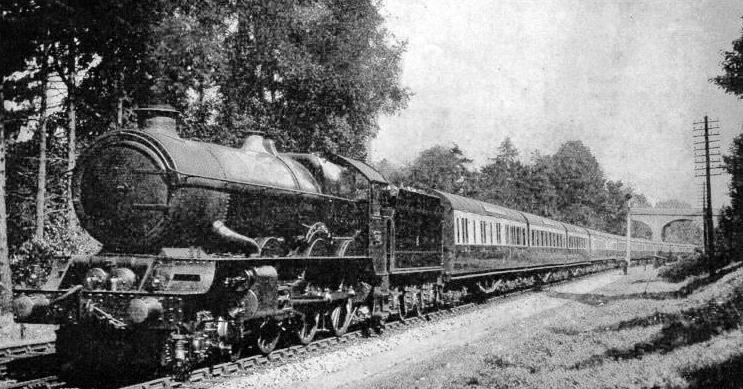
THE DOWN “CORNISH RIVIERA EXPRESS” near Reading West Station, thirty-seven miles out of London. The express is here being drawn by the “King” class engine “ King Edward I”. This, the most famous class of GWR express locomotives, normally hauls the train.
Cut-off has been gradually increased to 25 per cent or so, but now twenty-five miles of “galloping ground” lie ahead, and the engine is notched up and the regulator partly closed. None of the descent is very steep, but the six miles of 1 in 222 down the Patney-Westbury cut-off are usually enough to produce a maximum of eighty miles an hour, or slightly over, through Lavington Station. At this point of the journey the “White Horse of Westbury” shows up prominently on a high hillside to the south of the line.
The “Cornish Riviera Express” no longer passes through Westbury Station. In 1934 two further new “cut-offs” were opened to avoid the curves through Westbury and Frome, both of which demanded a speed reduction to thirty-five miles an hour. The first of these branches is at Heywood Road Junction, about a mile east of Westbury, and the new line cuts through between the station and the town. We are due past Heywood Road at 12.2 pm - ninety-two minutes for the ninety-four and a half miles from Paddington.
This diversion has made necessary an alteration in the method of detaching the Weymouth slip portion. The guard now effects the severance of the train half a mile before reaching Heywood Road, and stops the coaches at the junction signal-box, where an engine is waiting to take them into the station. The slip carriages carry the regulation tail lamps, encircled by red-and-white disks. These are placed one above the other on the rear slip portion, but side by side on the inner slip portion, which is continuing its westward course on the tail of the “Limited”.
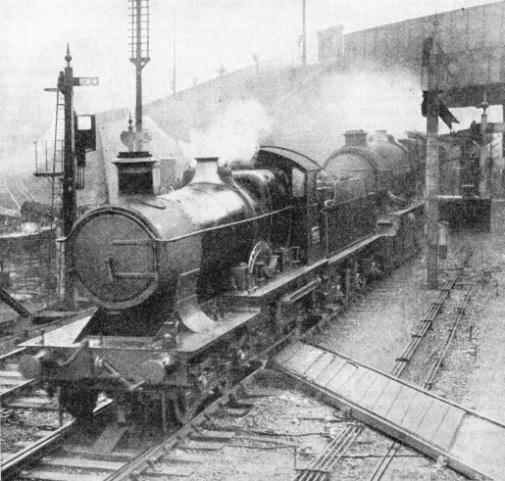
IF THE LOAD EXCEEDS 375 TONS behind the tender after the Kingsbridge coach has been detached at Exeter, the “Cornish Riviera Express” stops at Newton Abbot to pick up a pilot engine for assistance over the steep ascents to Dainton and Rattery Summits. During summer this additional halt is often made. A double-headed express is here shown approaching Plymouth.
Between the Westbury and Frome cut-offs the original main line is regained for a sufficient length of time to enable water to be taken from a second set of troughs Beyond Frome the line climbs again, on fairly easy gradients, to a summit called Brewham, marked by the 122¾ mile-post. This is not 122¾ miles from Paddington by the present route, but by the original route through Swindon, Chippenham, Trowbridge, and Westbury. At one time “mile-post 122¾” was regarded as of sufficient importance to have passing times of express trains shown against it in the working time-tables.
Now comes a steeper descent, with short pitches in it at 1 in 90, to Castle Cary; but, as it is somewhat winding, the driver will probably moderate the speed in some degree. At Castle Cary we leave the Weymouth route on the left, and cut across Athelney marshes at high speed, by the twenty-four miles spur line opened in 1906, which completed the Westbury route to the west. It rejoins Brunel’s original West of England main line at Cogload Junction, five miles short of Taunton, where a flying junction has now been constructed with four tracks through to Taunton station and for two more miles beyond the station.
Taking a third lengthy drink, from Creech water-troughs, the engine hurries the train through the fine new station at Taunton, 142½ miles from Paddington, and only 138 minutes in time. Here the guard of the Minehead and Ilfracombe slip portion releases his two coaches, and leaves our hard-worked “King” with ten only. This is as well, for there now lies ahead the steepest gradient to be encountered so far. This is Wellington bank, the site of the maximum speed attained, in the opposite direction, by the engine “City of Truro” in the high-speed mail train runs of 1904. The worst part of the climb is at 1 in 90 and 1 in 80, and then it flattens to 1 in 127 for the final three-quarters of a mile through Whiteball Tunnel, which brings the train out on Whiteball Summit, in the Blackdown Hills, in Somerset.
Nothing now remains of the “first lap” but a downhill run of twenty miles to Exeter, where the train comes to rest in St. David’s Station at 1.10 pm. Here the Kingsbridge coach is detached, leaving nine coaches, which weigh 313 tons when empty. Were the load to exceed 375 tons, it would be necessary to stop again, at Newton Abbot, as even a “King” would require, in such circumstances, to take pilot assistance. At summer week-ends, indeed, this additional stop is often made.
Immediately after leaving Exeter, at 1.23 pm, the train comes out on the right bank of the Exe, here an estuary of considerable size. On, this level stretch water is taken for the fourth and last time, from Starcross troughs, and speed is then reduced to fifty miles an hour over the sharp curves round the sea-coast between Dawlish and Teignmouth. Diving once again inland, we pass Newton Abbot, and it is obvious from the sound of the exhaust that the engine has now been “opened out”.
From Aller Junction, where the Torquay and Kingswear line branches to the south, the steepest pitch begins. Past Stoneycombe Quarries the engine arouses the echoes, for here a short strip of 1 in 36 must be mounted. The average for one and a half miles is 1 in 50, and from the footplate, as the train threads Dainton Tunnel and passes Dainton signal-box, it looks as though we were passing over the gable of a house. A swift descent leads from Dainton down to the valley of the Dart at Totnes, and then comes another formidable climb, known as Rattery. This consists of nearly two miles at about 1 in 50, followed by easier inclinations, until Brent has been passed and the summit level is reached at Wrangaton. On both these ascents cut-on on the engine will be worked up gradually to 35 or even 40 per cent, with the regulator full open.
Switchback Grades
Across the viaducts at Cornwood and Ivybridge the train now speeds, with beautiful views of Dartmoor to the north of the line, finally dropping down the precipitous Helmerdon bank - two miles at 1 in 42 - to Plympton and Plymouth. Passing Laira engine-sheds, we mount a short rise, and come to rest at North Road Station at 2.34 pm. Here our “King” comes off the train for a well-earned respite before beginning his next spell of duty.
For the Cornish section of the run a “Castle” class 4-6-0 takes charge. From Plymouth to Penzance there is an unbroken succession of steep switchback grades and sharp curves, so that no more high speed is possible - fifty to sixty miles an hour is the utmost limit on favourable sections. Soon after starting the train crosses the Tamar by Brunel’s magnificent Saltash Bridge, and after that many massive stone viaducts are crossed, replacing the wooden trestle bridges of earlier days.
Par is reached at 3.33 pm, and here we lose the Newquay coach. At 4.06 pm the train draws up in the cathedral city of Truro, and says good-bye to the Falmouth coach. Starting again at 4.10 pm, we then thread some of the rather dreary mining country of mid-Cornwall, past Redruth to St. Erth, reached at 4.48 pm, where the last couplings are undone and the St. Ives coach is left behind. After leaving St. Erth, we are soon in sight of Mount’s Bay, with the picturesque St. Michael’s Mount prominently in view to the south. At 5 pm the last remnant of the “Cornish Riviera Express” is at rest in England’s most westerly station - Penzance, 305¼ miles from Paddington. There it remains until the following day, when at ten am it starts the return journey.
During the summer of 1935, the “Cornish Riviera Express” is being run in two parts daily, the first, called the “Cornish Riviera Limited”, having no publicly booked stop to Truro, 279¼ miles from Paddington. Truro and St. Erth are the only halts and Penzance is reached at 4.45 pm, in 6¼ hours from London - the fastest time on record.
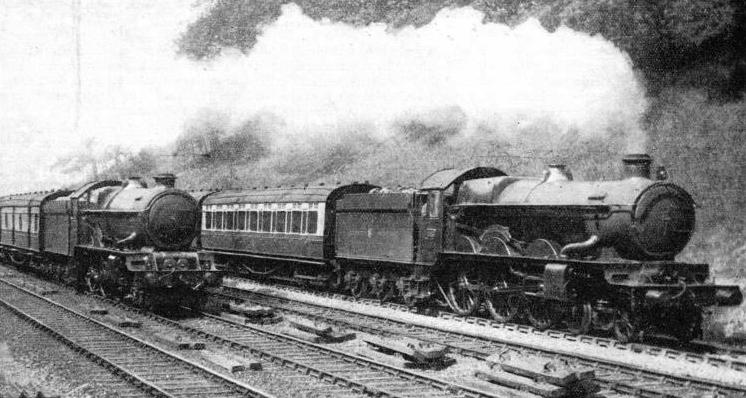
IN SONNING CUTTING, near Reading, “King James I”, on an express, is seen overhauling “Berkeley Castle”, hauling a slow train on the “relief” lines. “Castles” were used to haul the “Cornish Riviera Express” before the advent of the “Kings”. The “Kings” have the advantage over the “Castles” of 250 lb per square inch working pressure, as compared with 225 lb.
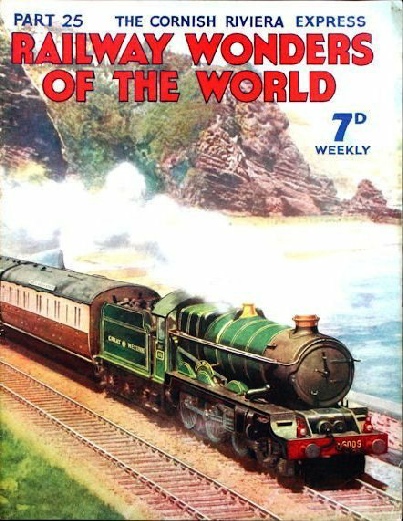
You can read more on
“The Cheltenham Flyer”,
“The Ports to Ports Express” and
“The Torbay Limited”
on this website.




 “CITY OF TRURO”. In 1903 the “City of Bath”, a similar engine, hauled a royal train between Paddington and Plymouth via Bristol in record time-
“CITY OF TRURO”. In 1903 the “City of Bath”, a similar engine, hauled a royal train between Paddington and Plymouth via Bristol in record time-





